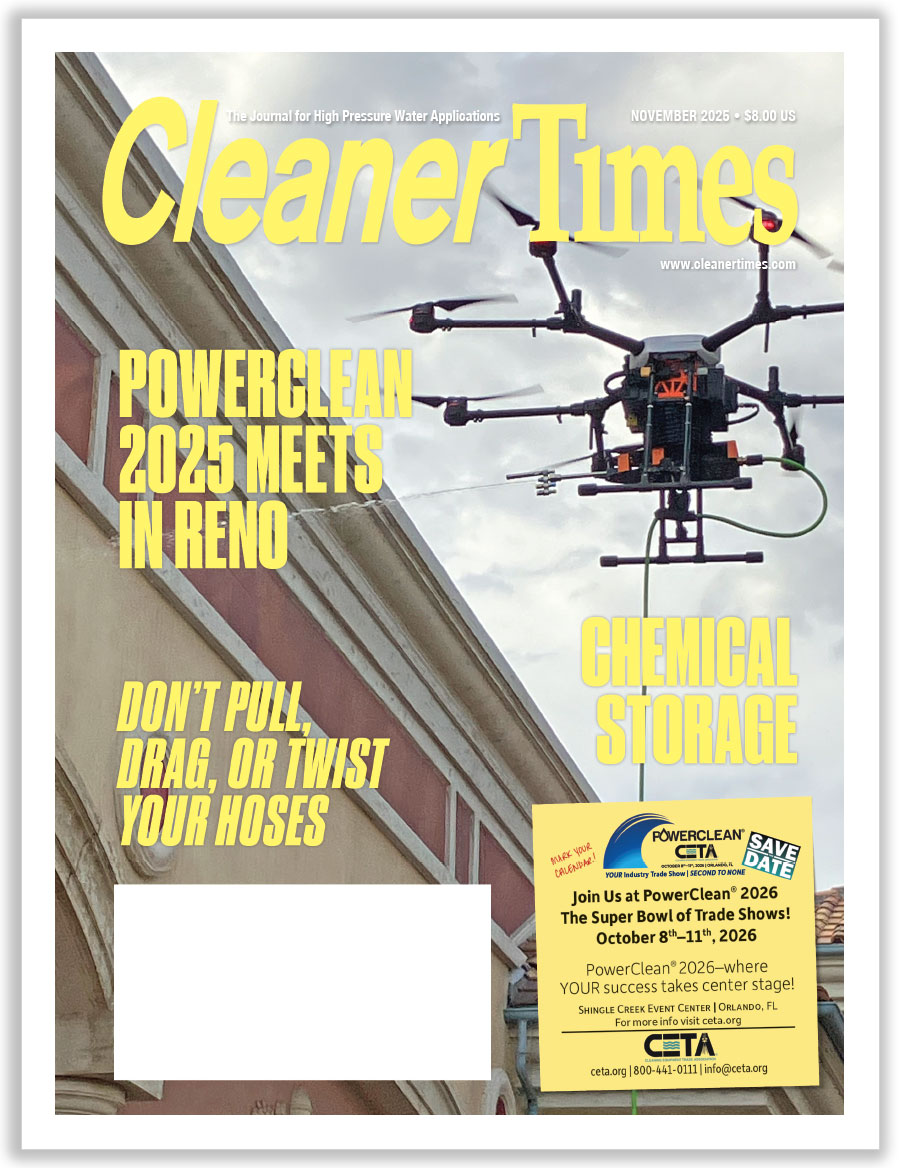
A Nuisance Is Not a Catastrophe
By Diane M. Calabrese / Published July 2018

P
revention of Pump Issues
A nuisance is not a catastrophe. A pressure washer pump failure is downright inconvenient, but it is not potentially fatal like a stopped heart or a metal fatigue breach.
Prevention is still the prudent course. End users who heed the advice of experts save time and money. They may also become more adept at recognizing subtle indications of trouble.
Build on the fundamentals. Start with the basics to make certain a pump serves out the lifespan for which it was designed.
“Change the oil at 50 hours break-in and every 500 running hours after that,” says Mike Hansen, sales manager-water division at Dultmeier Sales in Omaha, NE. “If the pump starts leaking water, packings need to be replaced. If oil is leaking, oil seals need to be replaced.”
Know which components have the shorter lifespans. “Pump seals generally last about 1,500 running hours,” explains Hansen. “Valves are about 2,500 hours.”
A contractor should be able to decide when to just make the repair and when to take the pump to a trained technician. “It depends on how mechanical he is,” says Hansen. “Seals and valves are relatively easy to repair in the field.”
Take full advantage of the instructions the manufacturer provides. “Most manufacturers have recommendations based on the type of customer or hours of equipment operation per day,” says Karl Loeffelholz, dealer division manager at Mi-T-M Corporation in Peosta, IA.
“For example, we rate our pressure washers as residential, commercial, or industrial,” explains Loeffelholz. The information accompanying the pressure washers—graphs and charts—enables independent dealers to sell the correct unit for a specific application.
Regular and as-needed oil changes are important. Just as with motor oil, some experts suggest more frequent changes. The key is to “follow the manufacturer’s recommended service intervals,” says Loeffelholz.
“Change the pump oil after the first 25 hours of operation and then every three months or 250 hours thereafter,” says Loeffelholz. “If oil appears dirty or milky, changes may be required more frequently.”
Many pump and pressure washer manufacturers aim to streamline the process of choosing by selling oil under their own label. Using the wrong oil or, worse, oil from the wrong sphere (e.g., automotive) creates unnecessary problems.
“Always change the crankcase oil at the intervals recommended by the pump manufacturer,” says Skip Markowitz, owner of EDI Distributors Inc. in Cherry Hill, NJ. “And be sure to use the correct grade of oil.”
Time of year and latitude factor in the selection of oil. Choosing wisely eliminates the need for what may be extensive repairs, says Markowitz. “For those in cold weather areas, freeze damage is avoidable.”
Parts of a pump may be working fine, but use hours of service and not the seems-to-be-okay approach as a guide. “Pump seals are like tires on a car,” says Markowitz. “After 40,000 miles, tires need to be changed. Once seals start
to leak, they can only get worse and possibly allow water to enter the crankcase, causing significant damage.”
Markowitz reemphasizes that the more end users know, the better they will be able to determine when it’s time to seek help. “There are now many good videos on YouTube. Watch one. If the scope of the work looks above your pay grade, hire a pro.”
Water and Balance
Right alongside attention to oil should be attention to water. “Water. Plain and simple, the best thing you can do for a pump is give it an adequate supply of water,” says Ben Hagemann, general manager at American Pressure Inc. in Robbinsdale, MN. “This means water that isn’t too hot, isn’t frozen, doesn’t contain air, is free of debris, and can get into the pump through a soft hose.”
Ensure that no air is entering the system. “Even on a pressure-fed system that you would hook to a garden hose, if there is a drip, that is a place it can also draw in air,” says Hagemann. “Air leads to cavitation and decreased seal and pump life.”
Whichever way water is entering the system, make sure it’s just water. “When drawing water from a tank or on a machine with a float tank, the pump will draw water under a vacuum. It is important to make sure there are no air leaks, and address any fluctuation or flutter in pressure as soon as you notice it,” says Hagemann.
A hole or crack in a straw make it impossible to sip and enjoy a beverage. The effect is more devastating in a pump, explains Hagemann. “In an analogous way, air on the inlet will prevent you from operating at full pressure and will destroy your pump over time or even very quickly.”
The water supply line must be “adequate in size for the pump” and coiled up extra hose length should be avoided, says Hagemann. “Try to come in straight into the pump and eliminate as many turns as you can on the inlet of the pump. A smooth, straight flow of water is best.”
Distributors can help with configuration. “Get to know your dealer or supplier on the products,” says Hagemann. “Our company helps customers plumb in systems all of the time. We will use a vacuum gauge to make sure the pump is running inside specifications and often have suggestions for improvements that can be made. Even if it isn’t a system we sold, we will take the time to make suggestions and give advice, so customers can get the most life out of what they have.”
Manufacturers and distributors want end users to have the optimal machine for the task at hand. Always “purchase a pressure washer that is intended for the type of work and duty cycle you are involved in,” says Al Stasny, technical manager at A.R. North America Inc. in Fridley, MN.
“Set up a preventative maintenance schedule and daily check list,” says Stasny. “Preventative maintenance can not only reduce the risk of injury, but also cut ‘down-time,’ increase profits, decrease costs, and increase equipment life.”
Do not ignore small problems. Repair them immediately, says Stasny. But he cautions that knowing how to do the repair is the paramount concern.
“Before anyone attempts to repair a pump or system, he or she should have proper training,” says Stasny. “If the owner-operator is not trained in specific repairs, stick to the basics—oil changes, repairing fitting leaks, and valve replacement.”
Stasny takes a conservative approach to parts replacement. He agrees seals generally have the shortest lifespan. “They see the most friction and wear in the pump,” he explains.
Do not just leap, though. “If the pressure washer is functioning correctly, I would not replace any parts until needed,” says Stasny. “Once you see either a fluid leak or loss of pressure, that would be the time to repair the problem.”
Balance is important, explains Stasny. “One of the most common causes of pump failure is improper or unnecessary service.” And it is often “a result of the operator attempting” to make the adjustments. “Each time the pump is serviced, the chance of pump failure—as a result of improper service—increases.”
Getting It Right
Receiving the most reliable and longest possible service from a pump begins with following the recommendations of the manufacturer. It culminates with the end user weighing the minor differences in advice from manufacturers and distributors and using all the information available to make an informed decision. Fortunately, end users have a wealth of good advice to tap. More tips follow.
A pump’s full lifespan will be realized if the pressure washer owner gives it the care it deserves. “Prior to starting the engine, flush water through the pump by turning on the water supply and squeezing the trigger on the gun,” says Chris Schuelke, business development manager at Cat Pumps in Minneapolis, MN. “This allows water to fill the pump and flush any air.”
Attentiveness encompasses all dimensions of the pressure washer. “Make sure there is an adequate water supply while pressure washing,” says Schuelke. “Running a pump dry or cavitating will ruin seals in a short amount of time. Avoid continuous by-pass—trigger gun closed for more than two or three minutes—which causes excessive heat buildup in the water being pumped.”
Make use of the tools a manufacturer offers to ease life for an end user. “High- and low-pressure seals are the most common wear items that require servicing,” says Schuelke, noting that his company offers seal kits. “A seal kit replacement is an easy maintenance item, and service can be done with standard tools.”
Pump manufacturers want end users to have a long and good relationship with their pump. “Our pumps are relatively easy to service, especially for the discharge manifold end—seal kits and valve kits,” says Schuelke. “Our company has produced a series of service videos available on our website and YouTube channel. The mechanical drive-end is where trained service technicians might be better prepared to service rather than most do-it-yourselfers.”
Ardent DIYs will not be discouraged, so giving them tools makes sense. At the same time, some experts wish more contractors would shun the DIY route.
“I always recommend that cleaning contractors have their pumps serviced by a trained technician,” says Jimmy Welch, the R&D Manager for Nilfisk HPW based at Pressure Pro in Fort Pierce, FL. He expresses the concern that monetary savings may be short lived if the DIY effort results in more issues that must be resolved by a trained technician.
“In a real-life test, the pressure trapping unloader non-return valve is usually the first item to wear because of the cycling—10,000 cycles—on the gun, on-off,” says Welch. “And the best maintenance for this is to prevent any water leaks in the system. Check connectors, hoses, and guns.”
Seals are next. “The low-pressure pump seal will wear—600 to 800 hours—and then water will leak out and air can enter as well,” says Welch. “And the best preventive maintenance is as soon as a water leak from under the pump is evident, the pump should have a new seal kit installed—low and high-pressure seals; the valves—inlet and outlet—should be checked and if pitted—check poppet and seat—replaced as well.”
We put a question to experts about DIY pressure washers that are sold with disposable pumps. Is disposable the future in professional equipment? (‘No’ sums up their resounding response.)
Welch explains what distinguishes the disposable pump. “The axial—swashplate—‘disposable’ pumps that are used in the DIY market can have a 50 to 250-hour life. It depends on the design.”
Such pumps “usually have sealed drive ends and are considered ‘disposable’ because the machine—power and pump—are matched and the cost of the components is such that repair is not always cost effective,” explains Welch. It’s cheaper to buy a new pump.
“But there are also crankshaft pumps used in the larger DIY market, and some designs do have the ability to have sealed crankcases but also have means—drains and fill ports—so when the oil lubrication life is over, the pump oil can be changed,” says Welch. “Most professional crankshaft pumps are vented—open port to atmosphere, but depending upon the environment—high humidity—the oil can get contaminated. There are several crankshaft pump designs that have sealed power ends that can operate for up to 2,000 hours continuous service or three months with provided lubricant.”
Summing It Up
Yes, it’s possible for a pump to meet its full lifespan, says Welch. “Provide sufficient water flow and pressure.” That’s the key.
Welch explains that proper water supply and pressure is two times the rated flow available at the inlet—four gpm needs eight gpm supply—at 30 to 40 psi. He also says to change oil at 500-hour or three-month intervals; use a quality unloader, hose, and trigger gun; and inspect for water leaks.





